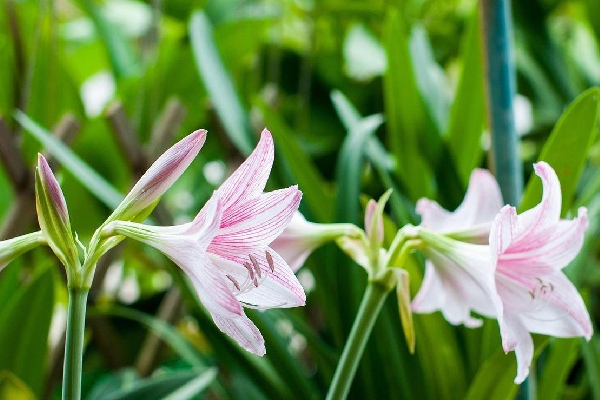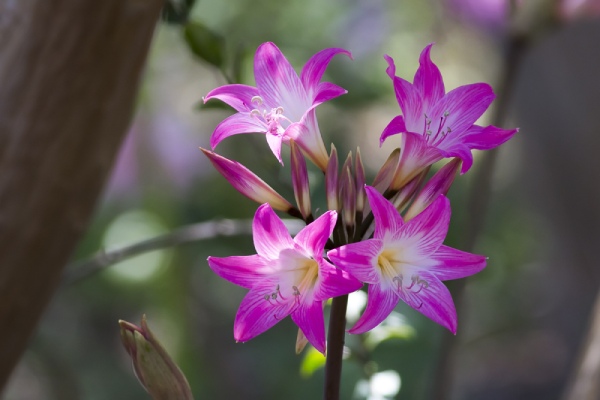Amaryllis are easy-care houseplants which could brighten a winter windowsill. And It is a favorite during the holiday season.
Few bulbs are as easy to grow as amaryllis, and few blooms with richness and beautiful. Simply plant the bulb in well-draining potting soil, water regularly, and provide bright indirect light. Plant support can be convenient for keeping the flowers upright, but almost nothing else is needed. Most varieties will begin blooming six to eight weeks after planting; some may take up to ten weeks.
If your amaryllis is not potted, grow each amaryllis bulb in a 6-8 inch pot. Heavier pots are preferable, as lightweight pots may tumble down under the weight of the flowers.
Plant the bulb with the pointed end up. Gently wrap the soil around the bulb, leaving about one-third of the bulb above the soil line.
Important tip: Do not use garden soil, as it does not drain properly. Place the pot in a location that receives bright indirect light. Water sparingly until you see about 2 inches of new growth. From that moment on, water regularly. As the plant grows, rotate the pot regularly to promote flower stem grow straight. Buds will appear at the top of each stem, followed by a dramatic floral display. To prolong the blooms, place the pot in a location with indirect sunlight.
Table of Contents
ToggleWhen Will Amaryllis Bloom?
This table gives you an idea of when amaryllis will bloom relative to the planting date. Amaryllis typically takes six to eight weeks to bloom, but check the label on the variety you have – some blossom faster, and some take longer.
| Planting date | Bloom time range |
| Oct. 15 | Nov. 19-Dec. 10 |
| Nov. 1 | Dec. 6-27 |
| Nov. 15 | Dec. 20-Jan. 10 |
| Dec. 1 | Jan. 6-28 |
| Dec. 15 | Jan. 19-Feb. 9 |
| Jan. 1 | Feb. 6-26 |
| Jan. 15 | Feb. 19-March 12 |
| Feb. 1 | March 8-29 |
| Feb. 15 | April 5-26 |

FAQ On Amaryllis
Q: My amaryllis is sprouting leaves but has not produced flower stems yet. Does this mean it won’t flower?
A: Some amaryllis bulbs sprout leaves first, followed by flower stems appearing slightly later. Others send up flower stems first, then emerges leaves. You should soon see flower stems emerging between the leaves.
Q: Do I need to fertilize my amaryllis?
A: Stored bulbs contain all the “food” your amaryllis needs for sprouting and flowering. If you decide to keep your amaryllis for reflowering next year, you’ll need to fertilize it as you would any indoor plant. Details are provided under “Rebloom for Next Year.”
Q: Can I use the flowers as cut flowers?
A: Yes! Amaryllis is becoming a popular cut flower, surprisingly lasting longer in a vase—up to two weeks—than when growing on the plant. Instead of placing tall amaryllis on a windowsill or sideboard, use relatively short vases and combine amaryllis flowers with other blooms and foliage to create an eye-catching table centerpiece.
Q: How many flower stems will my bulb produce?
A: This depends on the type of bulb, as well as the quality and size of the bulb. In general, the larger (for a specific variety), the better.
Q: Should I leave fading flowers on the plant, or should I “deadhead” as with outdoor plants?
A: When individual flowers begin to fade, you can carefully snip them off. Once all the flowers on a stem have faded, cut the stem back to within a few inches of the bulb.
For Next Year’s Blooms
Encouraging amaryllis to bloom again in the following year is possible with some planning and extra care, but it’s straightforward and very rewarding. After the flowers fade, trim the flower stems to within about 1 inch of the bulb. Continue watering and regularly feed the plant with liquid indoor plant fertilizer. Amaryllis will have many leaves during spring and summer. This helps the plant store energy for next year’s bloom. In mid-August, start withholding water, allowing the leaves to naturally wither when the pot is completely dry.
Store the dormant bulb in a cool, dark, and dry place for at least eight weeks; the longer, the better. Then, about six to eight weeks before you want the amaryllis to bloom again, repot the bulb in fresh potting soil and place it in bright indirect light. Continue watering—start with less water at first. Once you see new growth, increase watering, anticipating the upcoming floral display. By following these basic care guidelines, you’ll be able to see your amaryllis to bloom year after year.


Can you be more specific about the content of your article? After reading it, I still have some doubts. Hope you can help me.
Thanks for sharing. I read many of your blog posts, cool, your blog is very good.
I like this web site very much, Its a rattling nice position to read
and incur information.Raise your business
Thanks for sharing. I read many of your blog posts, cool, your blog is very good.